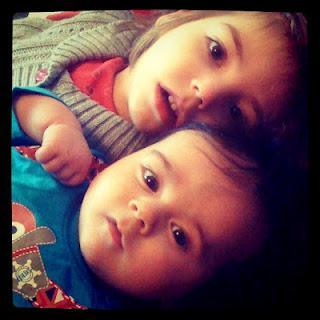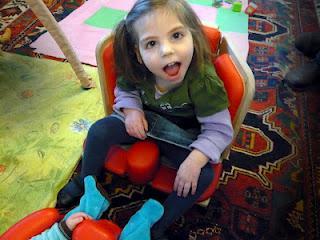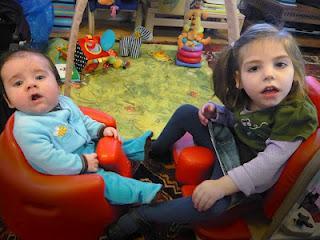 That Leonardo di Caprio once acted disabled won't surprise some.
That Leonardo di Caprio once acted disabled won't surprise some.In an early appearance in What's Eating Gilbert Grape? the actor affects what looks like classic CP behavior in order to illustrate his character's learning disability. It's very convincing - which must make actors with a real-life disability feel really cheated of a golden opportunity - and unfortunately, incredibly pervasive. The notion that it reinforces - that CP is both a physical and learning disability - isn't strictly true; the term cerebral palsy actually relates to motor impairment, although some people do have learning disabilities arising from the same brain injury that caused the CP.
Then again, di Caprio spent just a few days with teenagers with disabilities in his research for the role. Miles and I have spent two-and-a-half years watching our daughter's disability evolve.
Now that Isobel is approaching the benchmark age - according to her paediatrician, three is the age at which the main physical features of CP are firmly established - I am frankly relieved. When Isobel was diagnosed she was barely a year old, and was still a long way off from the behavioural stage at which her CP would manifest itself. Now, the unknown is at last becoming known, or at least an indication of what it could look like.
 This could mean us getting a crucial third piece of the giant jigsaw fairly soon. The first piece was the initial diagnosis that started the blog. The second was Isobel's MRI scan results, which confirmed quadriplegic CP. The third - that is yet to come - will probably be what type of CP Isobel has, and it's this that I believe we are seeing emerge now.
This could mean us getting a crucial third piece of the giant jigsaw fairly soon. The first piece was the initial diagnosis that started the blog. The second was Isobel's MRI scan results, which confirmed quadriplegic CP. The third - that is yet to come - will probably be what type of CP Isobel has, and it's this that I believe we are seeing emerge now.
(Not that it's the final piece: as well as CP Isobel has associated epilepsy and microcephaly - growing physical evidence of which we are also seeing. Even once the CP diagnosis is complete, I suspect there will be many more revelations to come. Thank goodness for that abundant mass of hair.)
Medical studies have identified three main types, but let's not get technical yet. Our discussions with Dr Mallya have not reached that far. Even so, just like di Caprio, I am finding myself noticing more and more how Isobel's mannerisms - the way she grins, laughs, kicks her legs excitedly from her highchair, and then stops abruptly to watch people with the utmost seriousness - typify CP behavior.
Not that this bothers us - the stares just remind us that this is an unfamiliar sight for many passer-bys - but we are aware how apparent Isobel's disability becomes in public once we lift her out of the buggy. After all, she's already physically over the developmental age at which she is expected to walk.
 Contrasting the elder child's behavior with the younger one is inevitable. It can't be helped - after all, Benedict is our first non-disabled offspring, and we're perpetually astonished at how quick and seamless his development appears to be. It drives home memories of my anxiety for Isobel in the first 12 months, when her milestones lagged behind more and more and I felt powerless to stop the delays.
Contrasting the elder child's behavior with the younger one is inevitable. It can't be helped - after all, Benedict is our first non-disabled offspring, and we're perpetually astonished at how quick and seamless his development appears to be. It drives home memories of my anxiety for Isobel in the first 12 months, when her milestones lagged behind more and more and I felt powerless to stop the delays.However much we love and get excited by watching Benedict learn to swat, grip and caress his toys in the playgym though, the emotional response he incites in us doesn't quite compare to his big sister.
Isobel put us through a lot, but only because she went through - and is still going through - a lot herself. As Miles says, she's a little fighter. She can't possibly like what she has to endure on a regular basis: the constant assessments, reviews, orthotics, equipment trials, rehab (although she does love PACE), having to take three bitter medicines twice a day. And yet, whatever the circumstances, she still manages to throw us a untrammelled belly-laugh, or another of her trademark wrinkle-nosed grins. It really melts our hearts.
The marvelous thing about Isobel is how she is introducing her baby brother to disability awareness. Of course, being just four-and-a-half months old Benedict is far too young to recognize how she might differ from other children. But the fact that he is in the room, intently watching his big sister get strapped in various pieces of orthotics or equipment, being given rehab exercises, or practicing standing, neatly generates a beautiful synergy.
We play on this by giving the children as much time together as as possible. I often sit Isobel next to Ben in his Bumbo or bouncer and read books to them both, or they could be placed directly opposite each other so to foster interaction. In the morning we nearly always change their nappies together on our bed, and at night-time, sometimes I bring Ben to Isobel in the kitchen, where she's having her supper, to say goodnight.
And we can see that our efforts are paying off. These days Ben will smile at Isobel whenever he sees her - and she'll respond by suddenly extending her arm towards him. When she does, we often encourage her to stroke Ben's hair or feet gently. She doesn't always get it right, of course, but when she stretches out her palm and kind of hovers it over him, we know she's getting there.

